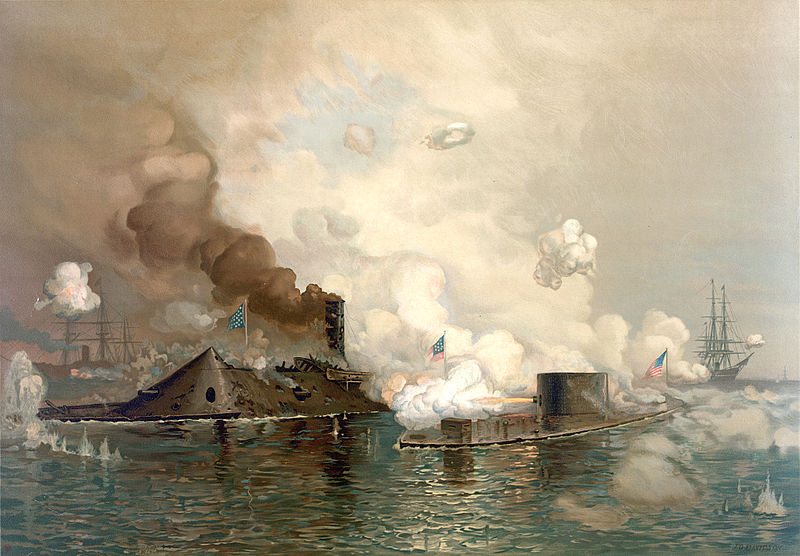The Federals from the start of the Civil War wanted to defeat the Confederacy by blocking access to southern ports for supplies and exporting cotton for revenue.
In response, the Confederacy began building a fleet of ships “clothed in iron panels” to make them resistant to enemy cannon fire. These “ ironclads”, also armed with an underwater ram, could slam into and sink the enemy’s wooden vessels. Three elements made up the ironclad: a metal-skinned hull, steam propulsion and guns that fired explosive shells.
Starting from scratch, the South was able to put into action more than 20 such warships. The North followed with a considerable fleet.
The Confederates had salvaged the Northern built Steam frigate Merrimack and rechristened her the Virginia. The upper hull was cut away and armored with iron and resembled what one source said, “a floating barn roof.”
The Union ironclad Monitor under the command of Lieutenant Worden, was described as a “Yankee Cheese Box on a raft. ” It had water-level decks and an armoured revolving gun turret.
Commodore Buchanan, with support of other Rebel vessels, had just successfully destroyed a Union fleet of wooden warships off Newport News. They managed to wreck the sloop Cumberland, the 50 gun frigate Cumberland, and run aground the frigate Minnesota. Confederate spirits were high.
Now the stage was set for the first real face off of two ironclads in the dramatic, history making Battle of the Monitor and Merrimack, also called Battle of Hampton, Virginia, on a March morning in 1862.
It was 8 AM. Crowds of Union and Confederate supporters gathered to watch from the decks of nearby vessels and the shores on either side.
The Virginia opened fire on the vessel Minnesota, and then the Monitor appeared. They passed back and forth on opposite courses, firing at each other without causing any damage. The Monitor could fire only once in seven or eight minutes, but was faster and more maneuverable. The Monitor’s pilothouse was finally hit, blinding Worden, forcing it into shallow water. The Virginia, figuring the enemy was disabled, turned again to attack the Minnesota. But with low ammunition, a leak in the bow, and lack of steam, the Virginia headed for its navy yard.
By 12:30 PM, the battle was over. The two ironclads had fought to a draw. But the event went a long way to boost morale. Maybe more importantly, from then on, naval battles would never be the same. This historical first duel between the ironclad warships marked the death of wooden ships as fighting vessels, and ushered in a new era of warfare.

